November 21st, 2013
When I pulled out all of the wood in my 75G while rescaping, I felt something slimy. Turning the wood over, I noticed a clutch of bristlenose eggs belonging to the Huacamayo Dwarf Ancistrus (L279) in that tank. I removed the eggs and put them in my shrimp tank, figuring that either the shrimp would eat them, or I’d get some fry. Well, I got fry!
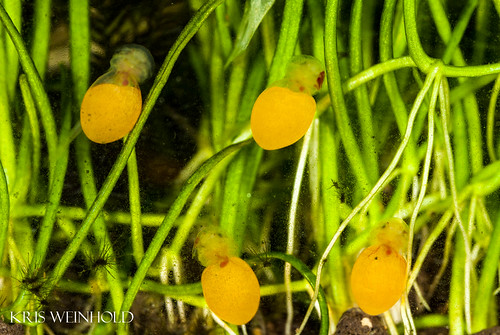
I noticed several of the eggs were hatching , with the head and tail first coming out. They then wiggled constantly try to further separate themselves. See the video below:
No matter how many times I find fry in my fishroom, it’s amazing to sit and watch them hatch.
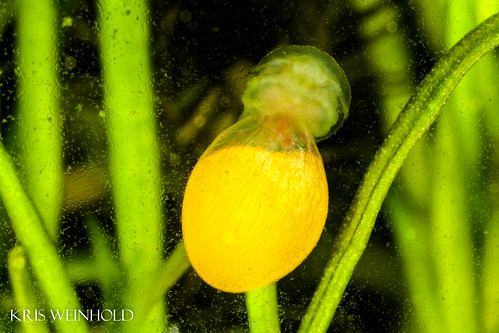
The Ancistrus fry truly are miniature versions of the adults, and they immediate suction themselves to the glass and scavenge for food once hatching.
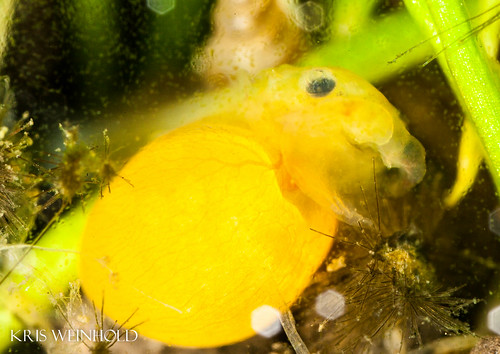
It’s even more amazing to see their hearts beating and blood pumping while still hatching out. See the video below of three young fry still hatching:
I probably have 20-40 fry in this batch. In the past , as long as I feed them well and keep up on water changes, most can survive without any problems.

If I’m lucky, they’ll all grow up to look like this.
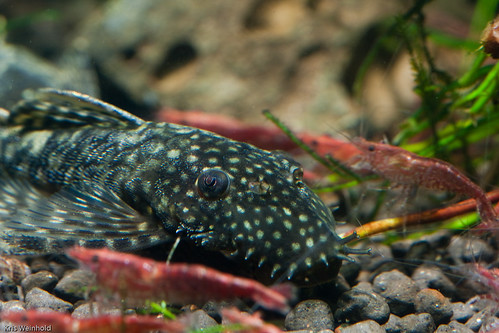
Posted in Fish Fry | 1 Comment »
January 7th, 2010
Sometime before the holidays, a pair of my generic bristlenosed plecos dug a hole under one of the rocks in my 50G aquascape and produced a spawn of 15-30 baby plecos. I knew they were nesting because I could see the parents initially fanning the ceiling of the rock where they dug their cave, presumably keeping the water fresh around all of their eggs. A couple of weeks later I noticed a slew of baby plecos clutching to the top glass all around the tank.
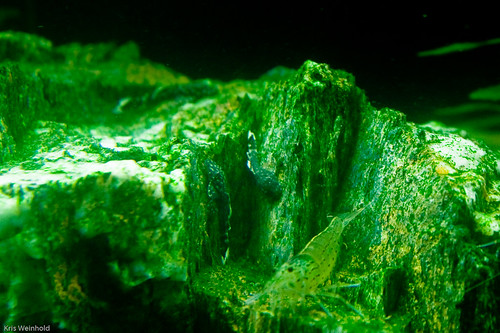
They hung around the glass for several weeks, but now they seem to have dispersed throughout the tank. In the picture above you can see three plecos cleaning the top of the largest rock in my aquascape. Obviously, the fish are still not huge as they are dwarfed by an adult Amano Shrimp. If anyone has any suggestions on what to feed these guys to grow them up a bit faster, I’d love to know. So far, I’ve just been feeding them algae wafers, and I feed the other fish in the tank frozen bloodworms and brine shrimp. Comments on anyone else’s pleco breeding experiences are welcome!
Posted in 50G Tank Log, Fish Fry | 2 Comments »
December 12th, 2009
In October, my Pelvicachromis pulcher ‘Super Red’ spawned and I had a whole swarm of little Krib fry swimming around in my 40G farm tank. After only a couple months of paying extra special attention to feeding them, I now have a group of decent sized fish. The largest ones are about 1.5 inches long, with the smallest being about an inch.
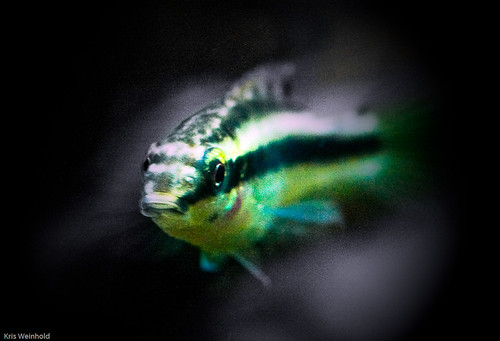
The parents have left them to fend for themselves, although so far they are getting along just fine with the parents. I don’t completely know how many young fish I have, however, because they have dispersed throughout the tank, and the only time I ever seen a number of them together is when I’m feeding them. At those times, I’ve counted 7-8 together, but it wouldn’t surprise me to have double that number hiding in the overgrown farm tank.

They have yet to get the brilliant colors that the parents display, but you can definitely tell that they’re kribs now. Small patches of color are starting to show up around the gills and fins. They have the distinctive squat (or maybe pear shaped) body where the belly seems a little bit too big in comparison to the rest of the fish. I’m not able to sex them yet, but I’m never great at that anyways with most fish.
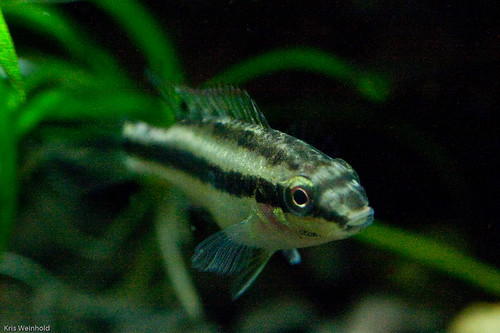
I’m really pleased with how easy these fish have been to keep and raise. The only thing I’m worried about is if the parents spawn again, and decide they don’t want their previous brood around anymore. If I see signs of spawning though, I may pull the parents out to their own tank to do their business.
Posted in 40G Tank Log, Fish Fry | Comments Off on Pelvicachromis pulcher ‘Super Red’ Fry Update
November 9th, 2009
A few months ago, I picked up a nice looking trio of Pelvicachromis pulcher ‘Super Red’ adults hoping that they would be ready to spawn quickly. I was very pleased when I noticed that they had done so about a week ago! I set them up on my 40G farm tank, but for awhile they didn’t really seem all that interested in each other.
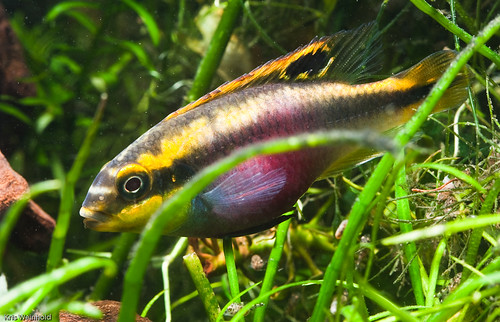
Then I realized, that being a farm tank, it didn’t have a single piece of wood or rock in it. I rectified that by making a small cave out of some porous mossy rock, and shortly thereafter, two of the fish paired off and took up residence in that cave. It wasn’t long until the female sequestered herself, and then shortly thereafter a swarm of fry emerged with the parents.
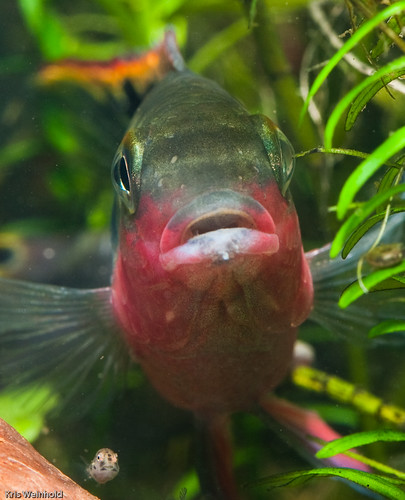
The parents escorted the fry throughout the tank, allowing them to feed on detritus on the substrate, and small organisms on the plant leaves. In addition, I used some frozen foods to supplement both the fry and parents diets, as the frozen cubes thaw and have a fine mist of brine shrimp pieces for the fry to graze on. I could visibly see the bellies of the fry bulging with food, so that always a good sign that they’re getting enough to eat.

Hopefully, the fry will continue to grow up fast, and I’ll have a small colony in the 40G. I’ve tried keeping these fish in the past, but for one reason or another, I’ve always lost the females before they would breed. I guess a male and a female fish don’t always pair up.
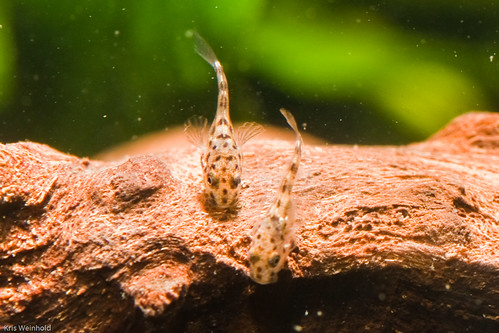
The fry don’t have any of the color on them that the parents exhibit, so I’m looking forward to seeing that develop as they get bigger. Once they’re big enough for blackworms, they should grow like crazy. (I hope). Comments welcome!
Posted in Fish Fry | 1 Comment »
October 1st, 2009
I went to feed the fish in my 75G this evening, and to my delight, one of my three Nannacara anomala females (I have a male and 3 females) were guarding a swarm of fry in the front right of the tank. Fortunately, this is the perfect place to take pictures, despite the dirty glass.
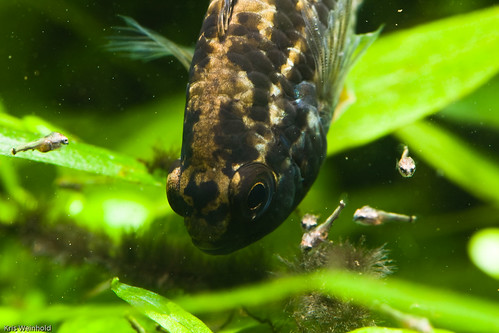
I’m wondering if the other females are also holding fry because the male was staying in another territory with another female, and wouldn’t come out in the open for a picture. Two of the three females are in breeding coloration, which is a predominantly black body with yellow highlights. Their normal coloration is mostly a drab yellow.
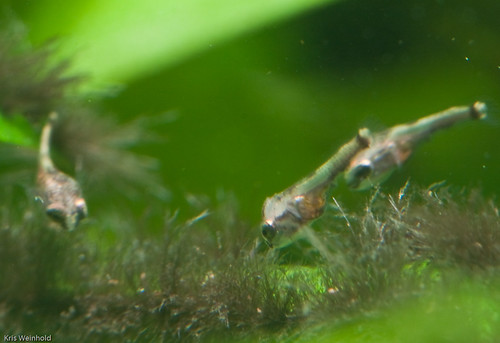
The fry were grazing on tiny micro-particles in the beard algae. (Yes I have a little bit of beard algae.) I dissolved a small amount of frozen brine shrimp, which floated down toward them. Being frozen, there were plenty of other smaller particles that the fry were able to fit in their tiny mouths. The female (and other fish) took care of the larger brine shrimp.
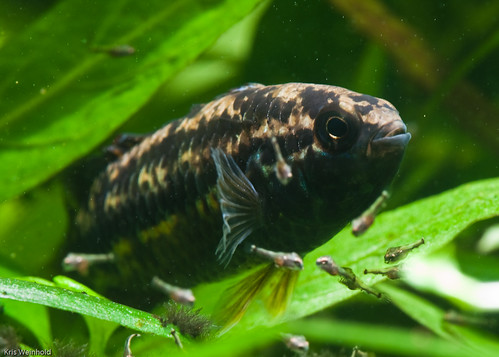
These Nannacara anomala are incredibly entertaining fish to watch. The females all have their territories, and the male glides back and forth between them without any commotion. If a female strays too far from her territory, a bordering female makes sure to chase her away, flaring fins and nipping. Fortunately, there’s plenty of room in the 75G for them to occupy without any major damage. Now, I need to focus on rising up these fry!
Posted in 75G Tank Log, Fish Fry | 7 Comments »
March 25th, 2009
I was sitting and enjoying my 75G aquarium this week, when I noticed a tiny little pleco sitting on one of my Cryptocoryne pontederiifolia leaves. Back when I converted my 54G aquarium to a native-themed aquarium, I moved all of the Ancistrus sp. ‘L279’ plecos from there into my 75G, where I already had a few. I had been hoping that they would breed for a couple years, but I guess the new mix of fish finally produced what I was after.
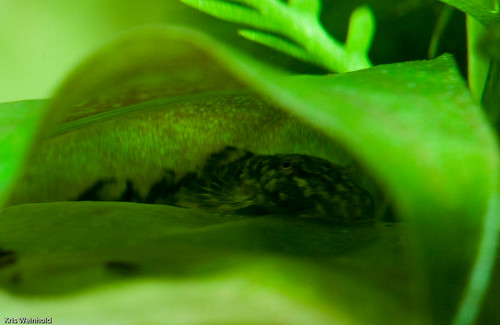
After spotting the one, I looked extra closely throughout the tank, and found at least 3 seperate individuals. They must have been in there for a little while because they’re all about the size of an Otocinclus right now, and actually look quite similar to one since their bristles haven’t yet started to grow on their faces. I hope all of these fry will grow up and start a little colony, as the L279 plecos are fairly hard to come by.
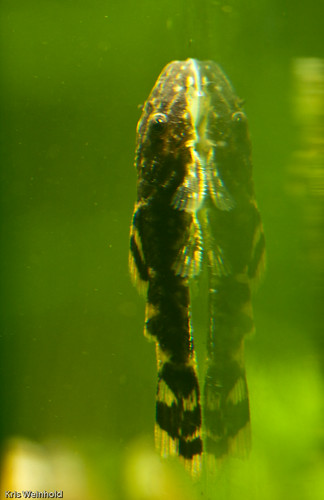
It’s really these little discoveries that make the aquarium hobby worthwhile for me. I spend so much time planted, trimming, feeding the fish, cleaning the tank, etc, that every once in awhile it is nice to find something come about that I wasn’t expecting.
Posted in 75G Tank Log, Fish Fry | 3 Comments »
September 8th, 2008
In a 20L aquarium, I have a small colony of Threadfin Rainbowfish, Iriatherina werneri, that I’m attempting to breed. These blue-eyes are beautiful fish that I’m hoping to eventually have a huge school for my 75G aquarium. The males are especially brilliant, displaying long fins, which they use constantly to prove their dominance to other males, and to impress females.

The males also tend to get a striking headlamp, a bright yellow/orange stripe along the top of their head, when they’re courting females. The females are not pictures here, but they do not have the elongated fins that the males do. It’s quite easy to tell them apart due to the noticable difference in finage.
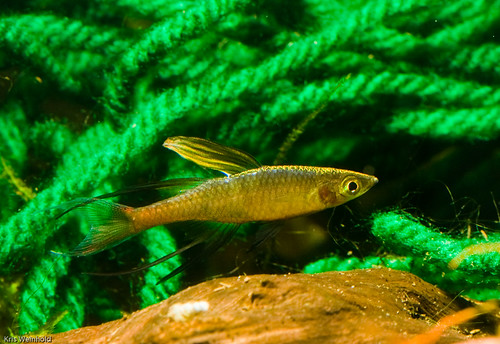
As you can see from the backgrounds in these pictures, I’ve been using spawning mops made from acrylic yarn to try and harvest eggs. The goal is to float these mops, have the fish lay eggs, and then remove the mop and place it into a hatching/rearing tank. By cycling two mops between these tank every 10-14 days, I hope to constantly have new fry. So far, I’ve been successful, but only on a very small scale.
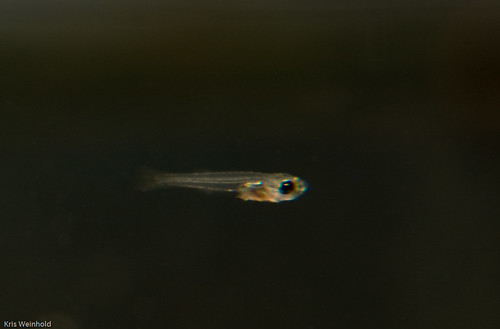
The fry are absolutely tiny when they first hatch; no more than a millimeter or two long. Right now, I have a couple that are 5-6mm long, but recently lost some to a Hydra infestation. I feed the newly hatched fry GP 5micron powder, which besides green water is just about the only thing that will fit in their tiny mouths. I’ve started feeding the larger fry some baby brine shrimp. Hopefully, they’ll grow up fast, and will be able to go in with the adults soon. If anyone’s successfully bred and raised these fish, I’d love to hear some advise.
Posted in 20L Tank Log, Fish Fry, Fish Profiles | 13 Comments »
April 28th, 2008
The Jewel Cichlids from Florida are at it again! Last week, I had a cloud of fry, with a dozen or two remaining today, but nevertheless the parents are protecting them. The fry spend much of there time combing through algae on the manzanita wood in the tank. If they ever venture too far away, the parents suck them in their mouth, and bring them back “home.”

And of course, the bonded pair are acting like psycho parents toward the other two Jewels in this tank. Fortunately, all of the cichlids have plenty of hiding spots, and are roughly equal size, so no one has gotten injured. That hasn’t stopped the parents from lording over 2/3’s of the tank, however.
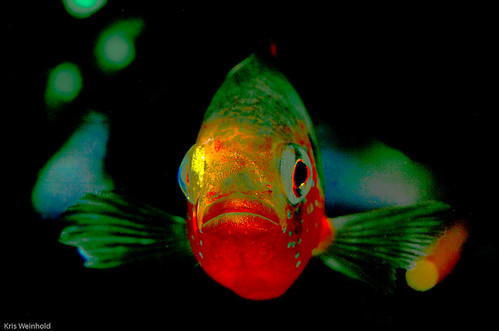
Despite being beautiful fish, I don’t really want anymore, so I’m not deterring much from my usual feeding routine with this batch of fry. I’ve added an occasional feeding of hatched brine shrimp and egg solution, but mostly I’m letting them fend for themselves. If a handful grow up, that’s great, but if not, I’m sure they’ll have more babies soon enough.
Posted in 20G High Tank Log, Fish Fry | 2 Comments »
March 1st, 2008
Over the past few days, I have noticed that my two females in the 40G have been bright yellow in coloration, and have remained very close to their caves. These are tell-tale signs that they’ve been spawning. It looks like the first female’s fry are now free swimming!

Right now, there is a sizable group of fry, with at least 20-30, but it could be even more. They move around so much, and they all look the same, that it’s near impossible to count. They spend most of the day grazing on tiny organisms and detritus throughout the tank, and especially on the porous mossy rock that contains all kinds of nooks and crannies for them to sort through.

Some of them even seem to take refuge in the small holes formed in the volcanic rock. I don’t plan on trying to remove the fry from the tank, so essentially it’s up to their parents and the cover of these rocks and plants to grow them up. I will, however, prepare a batch of baby brine shrimp for them this week to help them grow up big and strong.

Posted in 40G Tank Log, Fish Fry, Fish Profiles | 2 Comments »
September 7th, 2007
I noticed today that my adult jewel cichlids, collected in Florida, were acting more territorial than usual to their last set of offspring in the tank. Those young are now all 1-2 inches in length, and doing quite well. The adults, however, seem to have moved on, and are guarding a new patch of eggs.
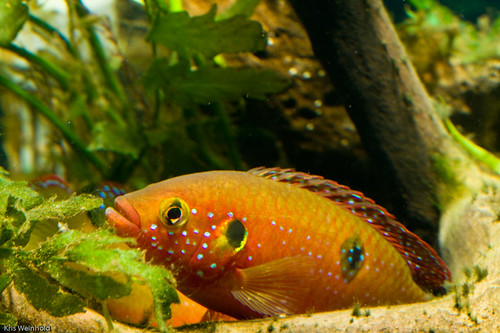
They’ve taken a new spot this time, occupying the left side of my 20G high tank, underneath a manzanita branch. There are eggs scattered on the underside of the manzanita branch, but mostly on the surface of the rock directly beneath that.

The parents take frequent turns guarding and fanning the eggs. I probably spent a collective hour watching them today, and their rotation is really only about 1-2 minutes before the one roaming the tank comes back to the nest, switching places with the other one. That said, the female does seem to spend more time guarding the nest while the male patrols, but not by too much.

I suppose this means that I ought to move the previous fry from this tank into their own dedicated one before the eggs hatch. If there are new free-swimming fry, I fear that the last batch will be eliminated by the parents.
Posted in 20G High Tank Log, Fish Fry | 1 Comment »




























